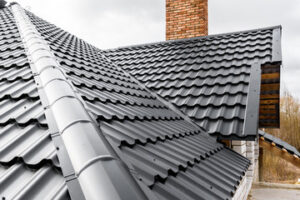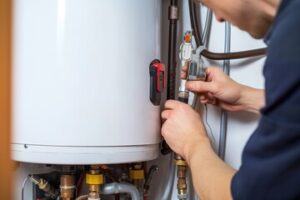Metal Roofing Missoula comes in a variety of colors and styles that can complement any architectural design. They’re also highly insulative, which can help lower cooling costs during the summer.
The type of metal roof, size, and installation labor charges will all affect your cost. However, other hidden costs can increase the total.

Low Maintenance
A metal roof offers a cost-benefit advantage that makes it an excellent choice for homeowners who are looking to minimize maintenance and repair costs. Unlike asphalt shingles, which require frequent repairs and replacement, metal roofing is extremely durable and resistant to harsh weather conditions. It can withstand high winds, heavy rains, and hail without corroding or cracking, making it an excellent option for regions with frequent severe storms.
Aside from regular debris removal and inspection for potential minor issues like exposed fasteners, metal roofs are relatively low maintenance and rarely require repairs. This significantly reduces the overall cost of ownership and provides a significant return on investment for homeowners, not to mention adding value to their homes.
When choosing a metal roof, it’s important to consider the thickness of the material and how well it will withstand various weather conditions. For example, a thinner aluminum roof will be more affordable but may not stand up to the elements as well as thicker copper or steel options. Additionally, the type of roof pitch and installation method will impact the final cost.
Installing a metal roof requires skill and expertise, and unless you have experience with roofing, it’s generally recommended that you hire a professional for the job. A qualified roofing contractor will have the necessary skills and equipment to complete the project safely, as well as provide a warranty and guarantee for their work.
In addition to a longer lifespan than traditional shingle roofs, metal roofing is also more energy efficient and less damaging to the environment. The reflective surface of a metal roof helps to cut down on the amount of energy required to keep a home warm or cool, saving homeowners significant money and helping reduce greenhouse gas emissions.
If you’re considering a metal roof for your home, be sure to speak with a roofing expert to choose the right style and color to suit your tastes and match the architecture of your house. Then, take a moment to compare the prices of different options and talk with several contractors to find a price that fits your budget and needs.
Increased Home Value
A roof is one of the biggest investments homeowners make in their homes. As a result, it is important to consider how your roofing choice will impact your home’s resale value when you are ready to sell. Metal roofs are an excellent way to increase your home’s resale price, thanks to their durability and attractive aesthetic. They also offer other benefits that can enhance your home’s curb appeal and make it more appealing to potential buyers.
A metal roof’s up-front cost can scare away some prospective homebuyers, but it is important to understand the long-term financial benefits of this roofing system. Unlike asphalt shingles, which need to be replaced every 10-15 years, a metal roof can last 40-70 years or more, saving you on replacement costs over the lifetime of your house. In addition, a metal roof requires minimal maintenance and is resistant to fire and insect damage.
Another financial benefit of a metal roof is its energy efficiency. The reflective properties of this roofing material can significantly cut down on cooling costs in the summer. This is a major selling point for potential buyers who are seeking ways to reduce their energy bills and carbon footprint.
The cost of a metal roof will vary depending on the materials and style you choose, as well as any custom features such as skylights or vents. In addition, the pitch or slope of your roof can affect pricing as well. For example, a steeper roof will be more expensive than a shallower roof. You should always consult with a reputable roofing company to get an accurate estimate for your specific project.
When choosing a roofing company, it is best to look for one that has been in business for a while and has a good track record. You can also check out their website for information on how they have handled past projects and to see any complaints or issues that may have arisen.
If you are planning to install the roof yourself, be sure to have a few helpers and safety equipment on hand to ensure your safety and the proper installation of the metal roofing. You should also consider hiring a professional roofing contractor to handle the job for you.
Longer Lifespan
When compared to conventional asphalt shingles, metal roofs have significantly longer lifespans. Their longevity means you’ll have to shell out less for repairs and maintenance over the years, saving you a lot of money.
The best part is that if your metal roof is well-maintained, it will also stand firm in the face of severe weather conditions such as high winds or heavy rains. The reason that it is so durable is because it’s designed with a special underlayment that prevents moisture and rust. Additionally, it has a protective coating that reduces noise and helps protect against hail damage.
These factors make metal roofing the most resilient and versatile option for homeowners. Depending on the type of metal and its design, some materials can last for up to 70 years.
Typical metals that are used for roofing include copper, zinc, and aluminum. Each type of metal has different average lifespans that are based on their climate, installation site, and maintenance routines. For example, copper is a long-lasting option because it has self-repairing properties that allow it to stay pristine even when faced with extreme weather conditions. On the other hand, aluminum and steel may degrade faster due to frequent temperature fluctuations and corrosive environments.
If you’re thinking of getting a metal roof, it’s important to choose the right contractor who is experienced with installing this material and understands its unique properties. A professional can help you determine the right type of metal that will suit your home and provide you with a comprehensive cost-benefit analysis.
You should also ensure that the installation team has proper insurance to protect you in the event of any accidents or property damage during the project. You’ll also want to know whether the roof is insulated and properly ventilated. It’s a good idea to avoid using harsh chemicals or abrasive tools, as these can damage the surface and void warranties. Regular cleaning and touch-up paint can prevent corrosion and extend the life of your metal roof. It’s also important to have the roof inspected by an expert to address any minor issues before they escalate into larger problems.
Energy Efficiency
Unlike conventional roofing materials, metal roofs reflect sunlight instead of absorbing it. This helps keep indoor temperatures cooler and reduces energy usage. Many metal roofing options even come with solar reflective coatings that can further help to decrease your energy costs by up to 20%. In addition to lower energy bills, a cool metal roof can qualify you for an insurance discount on your home or business.
Homeowners can recoup up to 85.9% of the cost of a metal roof, depending on location and other factors. This makes them a sound investment. They also add a higher resale value to the property, so you can enjoy the benefits of your metal roof for the lifetime of the structure, and then sell it at a good price.
A well-designed metal roof can be a beautiful and durable addition to your home. A wide variety of styles and colors are available, so you can choose the look that best suits your house. Most metal roofs are made of galvanized steel or copper and have a long lifespan with very little maintenance. Some types of metal roofs, like standing seam, do not have any exposed fasteners and require no regular painting or staining. Other types of metal roofs, such as the more economical exposed fastener panels, have fasteners that are visible but can be painted to blend in with the roofing.
Another benefit of metal roofs is that they are quieter when it rains than traditional shingles. While a shingle roof can make a loud pinging noise, a metal roof will usually be quieter due to the layers of insulation and drywall between the roof deck and the living space below.
It is important to remember that while a metal roof may seem expensive initially, it will last longer and save you money in the long run. It can also add to the resale value of your home and help you save on energy costs. With all these advantages, it is easy to see why more and more homeowners are choosing metal roofs for their homes.
